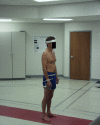Pre- and post-operative gait analysis for evaluation of neck pain in chronic whiplash
- PMID: 19615055
- PMCID: PMC2718879
- DOI: 10.1186/1749-7221-4-10
Pre- and post-operative gait analysis for evaluation of neck pain in chronic whiplash
Abstract
Introduction: Chronic neck pain after whiplash is notoriously refractory to conservative treatment, and positive radiological findings to explain the symptoms are scarce. The apparent disproportionality between subjective complaints and objective findings is significant for the planning of treatment, impairment ratings, and judicial questions on causation. However, failure to identify a symptom's focal origin with routine imaging studies does not invalidate the symptom per se. It is therefore of a general interest both to develop effective therapeutic strategies in chronic whiplash, and to establish techniques for objectively evaluation of treatment outcomes.
Methods: Twelve patients with chronic neck pain after whiplash underwent pre- and postoperative computerized 3D gait analysis.
Results: Significant improvement was found in all gait parameters, cervical range-of-motion, and self reported pain (VAS).
Conclusion: Chronic neck pain is associated with abnormal cervical spine motion and gait patterns. 3D gait analysis is a useful instrument to assess the outcome of treatment for neck pain.
Figures
Similar articles
-
A small group Whiplash-Associated-Disorders (WAD) patients with central neck pain and movement induced stabbing pain, the painful segment determined by mechanical provocation: Fusion surgery was superior to multimodal rehabilitation in a randomized trial.Scand J Pain. 2016 Jul;12:33-42. doi: 10.1016/j.sjpain.2016.03.003. Epub 2016 Mar 29. Scand J Pain. 2016. PMID: 28850488 Clinical Trial.
-
Self-rated disability, fear-avoidance beliefs, nonorganic pain behaviors are important mediators of ranges of active motion in chronic whiplash patients.Disabil Rehabil. 2013;35(23):1954-60. doi: 10.3109/09638288.2013.768302. Epub 2013 Apr 24. Disabil Rehabil. 2013. PMID: 23614356
-
Effectiveness of Intermediate Cervical Plexus Block in Whiplash-Associated Disorder: A Prospective Observational Trial in Fifty Patients.Pain Physician. 2023 Jul;26(4):E375-E382. Pain Physician. 2023. PMID: 37535784
-
Whiplash injuries: clinical picture and diagnostic work-up.Clin Exp Rheumatol. 2000 Mar-Apr;18(2 Suppl 19):S23-8. Clin Exp Rheumatol. 2000. PMID: 10824283 Review.
-
Some observations on whiplash injuries.Neurol Clin. 1992 Nov;10(4):975-97. Neurol Clin. 1992. PMID: 1435666 Review.
Cited by
-
Respiratory dysfunction in whiplash associated disorders (WAD) with cervical plexus syndrome - A case report.Surg Pract Sci. 2025 Jan 12;20:100271. doi: 10.1016/j.sipas.2025.100271. eCollection 2025 Mar. Surg Pract Sci. 2025. PMID: 39991749 Free PMC article.
-
Combined chiropractic care and Tai Chi for chronic neck pain: A protocol for a pilot randomized trial.Contemp Clin Trials Commun. 2025 Apr 11;45:101482. doi: 10.1016/j.conctc.2025.101482. eCollection 2025 Jun. Contemp Clin Trials Commun. 2025. PMID: 40321971 Free PMC article.
References
-
- Spitzer WO, Skovron ML, Salmi LR, Cassidy JD, Duranceau J, Suissa S, Zeiss E. Scientific monograph of the Quebec Task Force on Whiplash-Associated Disorders: redefining "whiplash" and its management. Spine. 1995;4:1S–73S. - PubMed
-
- United Nations Economic and Social Council Proposal to Develop a Global Technical Regulation Concerning Head Restraints. TRANS/WP.29/AC.3/13. 2005.
-
- Rauschning W, Jónsson H. In: Whiplash injuries. Current concepts in prevention, diagnosis, and treatment of the cervical whiplash syndrome. Gunzburb R, Szpalski M, editor. Philadelphia, PA: Lippincott-Raven Publishers; 1998. Injuries of the cervical spine in automobile accidents: pathoanatomical and clinical aspects; pp. 33–53.
LinkOut - more resources
Full Text Sources
Other Literature Sources


